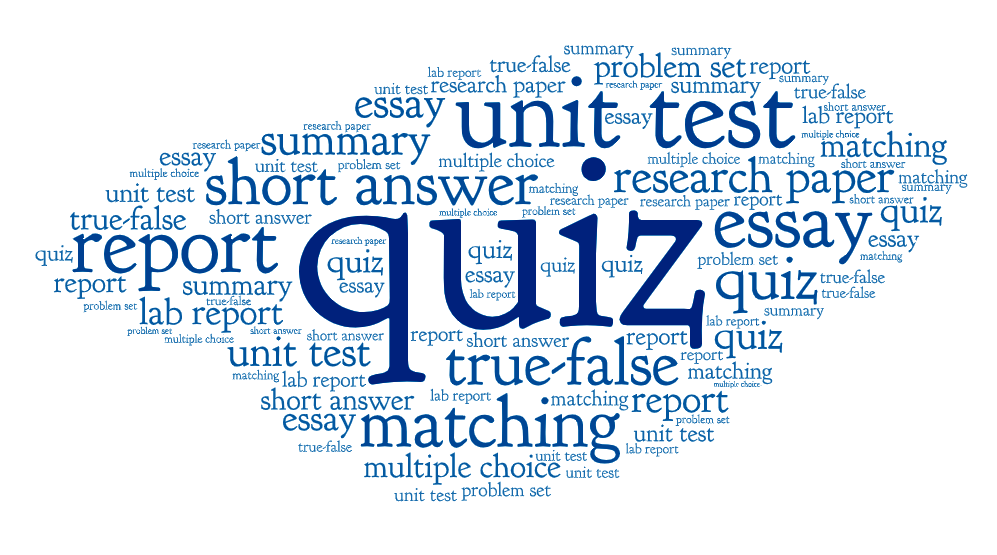Module 3: Assessment Strategies for a Virtual Environment
Traditional Assessments in Virtual Environments
Traditional Assessments in Virtual Environments

Traditional assessments measure knowledge and understanding by guiding learners to:
- recall facts and concepts
- measure their own improvement over time
- comprehend and restate ideas
- articulate knowledge
Quizzes, reports, essays, multiple-choice questions and unit tests are a few examples of traditional assessments.
Traditional assessment methods are common in virtual learning environments such as learning management systems (LMSs) like Blackboard, D2L Brightspace and Moodle.
Benefits
When accessed in an LMS, traditional assessments are fairly easy to assign, submit and grade. LMS companies are continually improving assessment tools to improve accessibility and functionality, and make student evaluation more user-friendly for post-secondary instructors.
Limitations
While traditional assessments can, in some cases, encourage students to apply new knowledge, they offer little opportunity for collaboration and strategic problem solving. They do little to teach us about who learners are, what their goals are, and how you as a teacher can help them meet their goals.
Traditional assessments can create barriers to learning when:
- their format and design are inaccessible
- their instructions are unclear
- their evaluation methods are unfair and not inclusive

Knowledge Checks: An Example of Online Traditional Assessment
A common example of online traditional assessments is a knowledge check, which is a quick and easy strategy for students to self-assess their understanding of content as they work their way through learning modules at their own pace. Knowledge checks are traditional examples of formative assessment, in which learners can gauge their in-process learning to ensure they can understand, remember and apply concepts and ideas in a low-stakes environment.
Knowledge checks guide us in our planning, helping us monitor learner participation and identify gaps for learners who are struggling.
Key Points of Knowledge Checks
Knowledge checks usually consist of two to four questions with no penalty for incorrect responses. Students who provide the incorrect response are prompted to try again. Sometimes each response will prompt an explanation to provide context and better support learning.
Here’s an example of a knowledge check.
Tip: Creating online knowledge checks is straightforward. It takes just a few minutes for teachers to build them directly in the LMS. Alternatively, they can find free and easy digital tools such as quiz generators, then embed the quiz into the LMS.
Traditional Assignments Provide Structure
Traditional assignments provide structure for educators because they help us:
- assign grades
- conduct knowledge checks to see where learners are at
- figure out who was paying attention and who wasn’t
- compare learners against standards
- compare learners against each other
In the slides below, use the arrows to read some of the reasons why teachers use traditional assessments in online environments.
Knowledge Check: Traditional or Not?
Let’s review your understanding of traditional assessments with another knowledge check activity.
Here are some examples of assessments that are common in virtual learning environments. Each is assessing student knowledge of military service of Indigenous Peoples and Black Canadians.
Review each assessment below and indicate if it is a traditional assessment or a non-traditional assessment. For each traditional assessment, review the proposed alternative assessment. Use the arrows to navigate through all four assessments.
Reflection
Traditional Assessments as Barriers to Learning
Earlier, we discussed how traditional assessment practices can create barriers to learning when their format and design are inaccessible, when instructions are unclear and when evaluation methods are unfair and not inclusive.
Students may struggle with traditional assessments when:
- time limits are not realistic
- the weighting of the assignment does not reflect the amount of work that goes into the completion of the task
- assessment topics are unrelated to the learning materials or course goals
- assessments are not authentic because they don’t apply to the real world
- there are no opportunities for self-expression

Tips to Removing Barriers in Assessments[1]
- Use concise, plain language in assessment instructions.
- Provide instructions and rubrics ahead of time, and encourage questions.
- Expect application, not memorization.
- Make connections to real-world situations and complex problems.
- Follow UDL principles in assessment design.
- Provide choice for students in topics and processes.
- Use multiple modes of representing information.
- Support learner variability by asking students to present information in a mode that suits their preferences (graphic, written, spoken, musical, etc.).
- Allow for revisions and consider “ungrading.” Instead, provide constructive feedback in writing or in audio format for meaningful revisions.
Key Takeaways
While designing online assessments such as multiple-choice tests and end-of-module knowledge checks, be mindful to reduce and remove barriers by lowering the stakes. For instance, consider removing time limits, and find opportunities for students to self-assess and reflect on their progress.
- Cast, UDL and Assessment. UDL on Campus. Retrieved December 15, 2021, from http://udloncampus.cast.org/page/assessment_udl#l1970365 ↵

